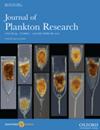巴伦支海大西洋和北极地区生态系统中桡足类和支海类的丰度和生物量
IF 2
3区 环境科学与生态学
Q2 MARINE & FRESHWATER BIOLOGY
引用次数: 0
摘要
摘要自20世纪80年代中期以来,每年都对巴伦支海的浮游动物进行监测,并采用标准程序确定大小分馏生物量。根据文献中测量的丰度和个体重量估算了桡足类和枝海类的生物量。桡足类中以虾足类占优势,约占总生物量的85%。其次是Oithona spp. (~0.5 g dw m−2,~10%),其次是Metridia spp. (~0.15 g dw m−2,2 - 3%)和pseudoalanus spp. (0.10 ~0.15 g dw m−2,1-5%)。枝海类群(Evadne和Podon)的估算生物量较低(0.01 g dw m−2)。中等大小部分(1 ~ 2 mm)的生物量主要由Calanus sp .贡献,而小桡足类(Oithona、pseudoalanus等)的生物量则为1 mm。小桡足类和小桡足类总生物量与浮游动物总生物量呈显著正相关(R2分别为0.72和0.34)。大西洋和北极水体中,小桡足类与大桡足类的生物量之比相似(~0.15 ~ 0.2),但随总生物量的减少而增加。这表明随着小桡足类动物数量和总生物量的减少,小桡足类动物的作用逐渐增大。本文章由计算机程序翻译,如有差异,请以英文原文为准。
Abundance and biomass of copepods and cladocerans in Atlantic and Arctic domains of the Barents Sea ecosystem
Abstract Zooplankton in the Barents Sea have been monitored annually with a standard procedure with determination of size-fractioned biomass since the mid-1980s. Biomass of copepods and cladocerans was estimated based on measured abundance and individual weights taken from literature. Calanus species were dominant, making up ~85% of the estimated biomass of copepods. The second most important taxon was Oithona spp. (~0.5 g dry weight (dw) m−2, ~10%), followed by Metridia spp. (~0.15 g dw m−2, 2–3%) and Pseudocalanus spp. (0.10–0.15 g dw m−2, 1–5%). Estimated biomass of cladoceran taxa (Evadne and Podon) was low (0.01 g dw m−2). Calanus spp. contributed most of the biomass of the medium size fraction (1–2 mm), whereas small copepod species (Oithona, Pseudocalanus and others) contributed to the small size fraction (<1 mm). Estimated biomass of Calanus spp. and of the sum of small copepod species were both positively correlated with measured total zooplankton biomass (R2 = 0.72 and 0.34, respectively). The biomass ratio of small copepod species to Calanus was similar in Atlantic and Arctic water masses (~0.15–0.2) but tended to increase with decreasing total biomass. This suggests a shift to relatively larger roles of small copepods as Calanus and total biomass decrease.
求助全文
通过发布文献求助,成功后即可免费获取论文全文。
去求助
来源期刊

Journal of Plankton Research
生物-海洋学
CiteScore
3.50
自引率
9.50%
发文量
65
审稿时长
1 months
期刊介绍:
Journal of Plankton Research publishes innovative papers that significantly advance the field of plankton research, and in particular, our understanding of plankton dynamics.
 求助内容:
求助内容: 应助结果提醒方式:
应助结果提醒方式:


